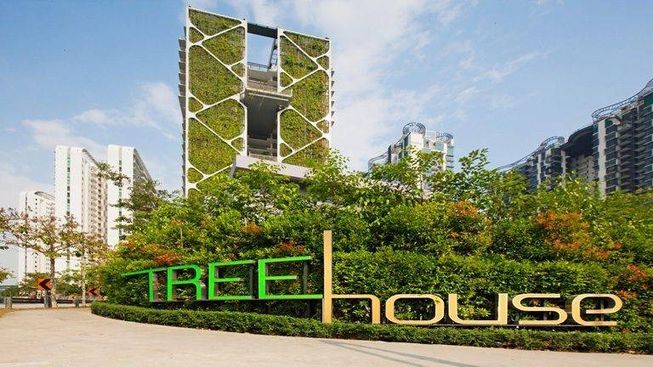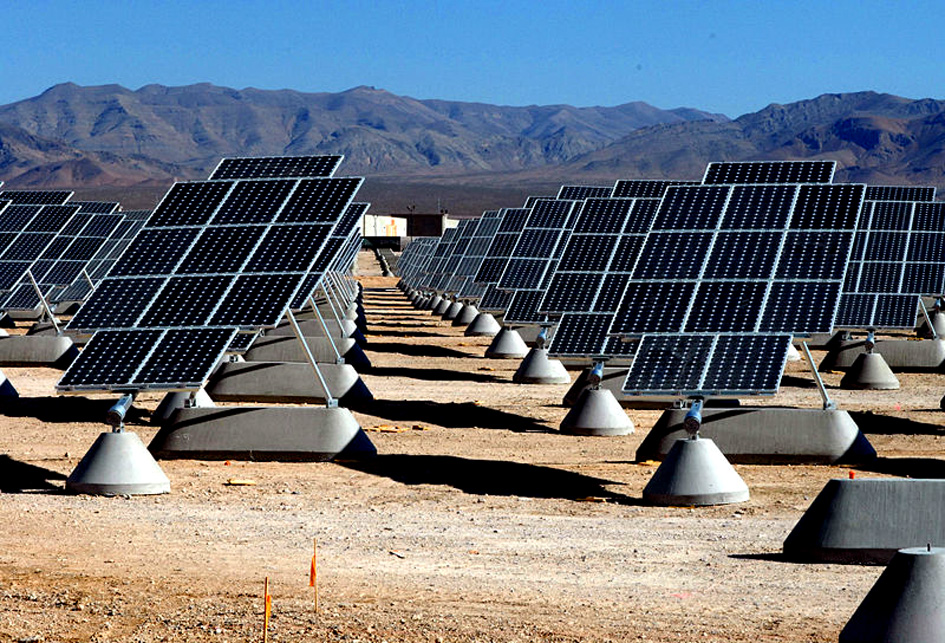Singapore’s not shy of great modern buildings—Marina Bay Sands Hotel and the Colonnade, to name but two. The hot new thing in Singapore is Singapore’s 24-story “Tree House”, holder the Guinness World Record for largest vertical garden. That’s the kicker: the condominium’s largest wall features 24,638 square feet of vertical green space, a whole way of thinking green, beyond the charms of the rooftop garden.

All that Tree House greenery helps offset the building’s carbon footprint by filtering pollutants and carbon dioxide. The really cool part is that the greenery is the cool part: the garden aids in heat absorption, a theoretical boost to the building’s energy savings, by as much as 30 percent.
Other cities take note: vertical gardens scale with the building’s dimensions, unlimited by rooftop square footage.
This week we were at Apparel Textile Sourcing, Canada’s Premier Apparel & Textile International Sourcing Trade Show. It was held at The International Centre and featured sessions and speakers related to Trade Agreements, Global Supply Chain & Retail Panel, Global Design & Consumer Apparel Trends, more.
Our very own Helen Harakas was on a panel speaking about how sustainable action can eliminate poverty. Hit play below for a short clip!
The show also featured Fashion Meets Function: The ATSC Fashion Show. The show’s theme was ‘Evolution in Fashion’ where we saw fashion from the perspective of the student.
Back in the day, before Starbucks and baristas, coffee was an industrial commodity which almost entirely ignored the very farmers who produced the precious bean. Not until did fair trade best practices and transparent supply chains become industry standards—true certified provenance tracking—did the marketplace realize that consumers would pay a premium for coffee humanely sourced and fairly bought and sold.
Provenance, the traceability and trackability of a piece of clothing, from cotton seed to finished blouse, today barely skims the surface of the energy inputs alone for a fabric, never mind the toxicity of the dyes used or the working conditions of the artisans and loom operators employed to produce the fabric.
Until there’s a global standard—like the initial coffee breakthrough of free trade, which certified farmers weren’t getting ripped off by coffee brokers and distributors—that defines the energy and ecological footprint for a piece of clothing, then there’s little even the most activist consumer can do to differentiate an ethical piece of clothing from a sweatshop product.
Read more in the Textiles and Clothing Sustainability Study
A May 2017 research project reports that textile and clothing (T&C) workers are often among the first employees in emerging economies to earn steady income; the sustainability of the factories which employ these workers is mission-critical to lifting the entire economy and social development itself—T&C workers are primary consumers.
That compelling pieces of evidence is step one in rethinking the importance of bringing the global textile and clothing into the circular economy. But the clothing industry is enormously complex, employing fibre producers, yarn manufacturers, weavers, chemical processors, apparel industries, retailers, logistics and distributor partners, post-consumer actors, and service providers.
And “fast fashion” has telescoped the clothing and fashion life cycle—and amplified the demand for ever faster design and production turnarounds. Upshot? Global fibre consumption doubled between 1990 and 2010, inspiring all manner of dubious practices, including GMO’d cotton, fake organic fibres, terrible (not to say lethal) working conditions and unethical product sourcing and manufacturing.

It’s official: the rate of adoption of renewable energy—solar- and wind-power—is accelerating so rapidly that the market capitalization of the old grid—read: natural gas-, coal- and nuclear-power—is shrinking. In Germany, home to the green revolution for the past two decades, where German taxpayers subsidized what’s now the world’s most advanced energy market—one of the biggest energy concerns split off its shrinking ‘fossil fuel’ entity, an act almost unheard of in German corporate life.
Something’s up. In China, the numbers are staggering: China has one-third of the world’s solar capacity and the biggest electric car market on the planet. What’s more, projects that depend on petroleum somehow for future profitability are being shelved or abandoned at record rates…everywhere, pipelines most of all and that implosion of investor interest and thus political clout) could well bust Canada’s tar sands projects.)
For decades, two limiting factors prevented the renewables boom; both factors now have cracks all over them. The first was oil and coal prices and vast subsidies and preferential tax treatment of fossil fuels. The second is battery cost: renewables depend on naturally fluctuating energy flows from sun and wind.
Political and ethical pressures have begun—there’s a long way to go—to drive renewable energy efficiency straight at the heart of the petroleum industry. Right now, today, solar is nearly on par with the cheapest fossil fuel/nuclear energy generation. And the juggernaut of global adoption is just getting started.
Batteries? A single headline suffices: the massive Tesla/Panasonic “gigafactory” in Nevada will produce more lithium-ion batteries on its site annually than all of global production in 2013—and just last week Mercedes-Benz announced its own gigafactory south of Berlin. Electric cars are expected to be cheaper than orthodox cars by 2026.
The sheer speed of this massive adoption of renewables globally will drive down battery costs and thus accelerate even more the rate of adoption of renewables.

The International Union for Conservation of Nature (IUCN) reported May 17 that upwards of 31% of the estimated 9.5 million tonnes of plastic that enters the ocean annually could be from sources such as tires and synthetic clothing.
The National Oceanic and Atmospheric Administration defines microplastics as plastic fragments 5mm or smaller; microplastics are abundant polluters in all five major ocean gyres, NOAA says. The crisis doesn’t end there: multiple research projects demonstrate small ocean organisms ingest the microplastics, adding toxic pollutants to the food chain—including ocean products consumed by humans.
Releasing “primary microplastics”—plastics which directly enter the environment as “small particulates—ocean-going debris from tires and microfibres stems from a single action: friction.

Synthetic textiles break down during the friction of machine washing; tires release primary microplastics during contact with the road surface during normal driving.
CNBC noted the report identified seven “major sources” of primary microplastics: tires, synthetic textiles, marine coatings, road markings, personal care products, plastic pellets and city dust.
“Our daily activities, such as washing clothes and driving, significantly contribute to the pollution choking our oceans, with potentially disastrous effects on the rich diversity of life within them, and on human health,” Inger Andersen, director general of the IUCN, said in a statement on May 21.
“These findings indicate that we must look far beyond waste management if we are to address ocean pollution in its entirety,” he added.
In its report, the IUCN concluded that between 15 – 31% of all plastic deposited in the world’s oceans could come from primary microplastics.
“The findings of this report have important implications for the global strategy to tackle ocean plastic pollution,” emphasizes Joao de Sousa, marine project manager at the IUCN’s Global Marine Programme. “Synthetic clothes could be designed to shed fewer fibres, for example, and consumers can act by choosing natural fabrics over synthetic ones.”
In an earlier, parallel study, microplastics researcher Professor Mark Anthony Browne’s work revealed some 85% of the human-made material found on tested ocean shoreline were microfibres, and matched the types of material, such as nylon and acrylic, used in clothing. These too, Browne’s research shows, enter the human food chain.
Meanwhile, back on back on dry land, China, the world’s largest producer of textiles and textile products, has a freshwater quality crisis stemming from textile dye and microfibre pollution; the true cost of fashion is far more expensive than we think.
In 2014, Ryerson University fashion student Emilia Dallman Howley captured a series of interviews with thought-leaders whose work investigates the role of business ethics in a time of profound ecological stress, through the lens of the fashion industry’s accountability for its part in climate change.
Emilia Dallman Howley is a Canadian transplant now living in San Francisco. By day she is a Product Designer at Facebook and steering member of Women of Facebook Design. By night she enjoys most of what HBO has to offer and her collection of adult colouring books. Emilia’s epic piece (over 900 likes on Medium) on design and the career pressures on designers (fashion or digital) is Imposter-Syndrome.
Gear Patrol, the men’s online lifestyle magazine and online shop, has just run an exceptional set of interviews about sustainability in the fashion industry with five of the most influential designer/entrepreneurs in the business.

It’s must read! Inspirational stuff if you care about the environment as passionately as you do about looking good…and we hope you do!
At Brands for Canada we know we’re edging ahead in ensuring the best possible use—economically, ecologically, for social good—of our brand partners’ products. It’s no small accomplishment, for us all.
Here’s a long-lived project that’s so comprehensive and well-thought out, so exceptionally well-executed, that we just had to share it with you as a living, breathing example of sustainability.
Kalundborg is a seaport, population 20,000, on the northwestern coast of across Denmark’s home island, 110km due west of Copenhagen; in the early 1950s, the Danish state oil company, STATOIL, built a refinery and pipeline at Kalundborg.

A paradox: an oil facility sparked the world’s first industrial symbiosis system, a living, breathing network sof gritty industrial companies who—quite by accident at first, then organically—began to collaborate to use and reuse one another’s residual by-products and share energy, infrastructure, transport, and other critical resources.
Four decades old, Kalundborg’s a great example of a green-by-accident ecosystem that just kept growing from the 1959 founding of Asnaes, the clean coal-fuelled power station that’s still Kalundborg’s beating heart and Denmark’s biggest power source; Asnaes is being converted to biomass next year.

A public/private hybrid, Kalundborg lives and dies by participant communication; this is a very human entity, which continues to grow because the human relationships which brought Kalundborg to life actually work. You’ve got to hand it to those Danes: they know how to negotiate these things.
But the nuts-and-bolts interconnected sustainability isn’t touchy-feely green: it’s straight up engineering, dedicated to Kalundborg values. The organic waste from one factory’s enzyme production is converted to organic fertilizer by its neighbour; smokestack exhaust—including some really nasty sulphites—from one factory is captured and made into gypsum for sheetrock construction products. Fish farm waste recycles as nutrient-rich
The numbers speak for themselves. Water recycling/reuse has saved some 4.8 million cubic feet of water over the life of the project (that’s a serious freshwater lake); insulin production from the biggest insulin producer on the planet, Novo Nordisk, yields a yeast slurry which in turn produces biogas to fuel power production onsite. In 1981, when perhaps only Iceland and Sweden were thinking about geothermal for residential heating, Kalundborg’s residential steam heating was already supplemented by the industrial symbiosis, for some 3500 homes.
The eco-industrial park (EIP) operation builds itself if and only if the next link in the ecosystem makes economic sense; attempts to impose ecosystem thinking on industrial parks without clear economic benefits almost invariably fail. At present, there are hundreds of EIPs in the US, from simple recycling centres to full-on industrial parks like North Carolina’s ReVenture Park, the biggest US project now underway; Hong Kong’s Eco-Park is also underway; in Canada, Halifax Harbour’s Burnside Industrial Park has an active ecosystem within an orthodox industrial park with over 1300 businesses and some17,000 employees. Barcelona has plans underway for an industrial city based on Kalundborg, a combination seaport/industrial ecosystem driven by sustainable thinking.
H&M’s Close the Loop collection and Global Recycling initiative, have recycled more than 260 billion pounds of unwanted clothing. H&M donates regularly to Brands For Canada and last month, provided 705lbs of new clothing and accessories.
H&M encourages you to leave unwanted clothes at any of their stores. One recycled shirt can save 2,100 litres of water.
Learn more about H&M’s Close the Loop collection here and their sustainability projects here.